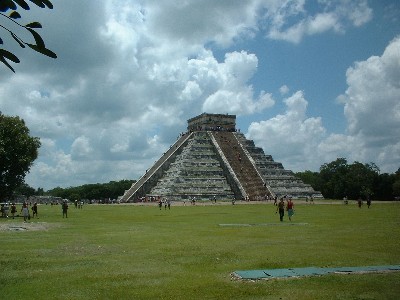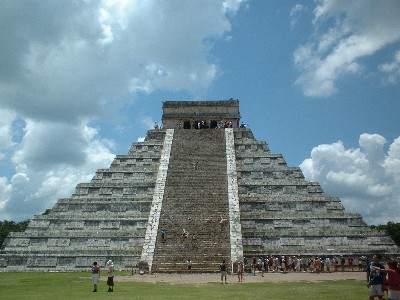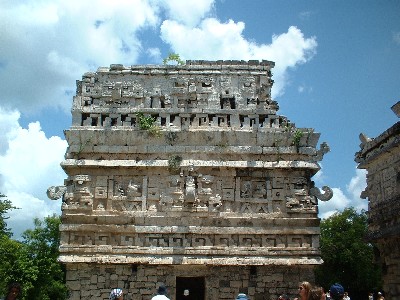|
Chichen
Itza
|
General Information and History
You have two options: (1) arrange a tour with
a company in Cancun or (2) driving to the site
in a rental car. We arranged a tour through our
hotel and although I enjoyed it I felt a bit rushed
to stick to the rigid schedule and will probably
drive on a return trip or stay at the hotel that
is near the ruins.
If you are driving, Chichen Itza is about 75
miles west of Cancun on Mex. 180-D. Be aware that
180-D is a toll road and when you take the Chichen
Itza exit you will have to pay close to $10! About
2 miles before getting to the site you will pass
through the small town of Piste. Here there are
hotels and restaurants which are a little more
reasonably priced than those near Chichen Itza,
although there is something to be said to staying
a day on site if you really want to see everything.
It is generally believed that Chichen Itza was
founded in the 4th century (AD) and served as
the center of Mayan life on the Yucatan peninsula
for several hundred years. Serious restoration
of the site began in the early 1900s. Of the several
hundred buildings that comprised the city, only
about 30 are restored. The rest remain covered
in brush and sometimes large mounds of dirt which
can be seen as you walk around the grounds.
|
 |
|

|
I have chosen to put some of my pictures up with
some interesting points and helpful hints, rather
than give a building by building description of
the site, since I believe it is something that
truly must be experienced and discovered while
you are there.
The best time to visit Chichen Itza is in the
winter months. However, not being able to select
the time of my sister's wedding, we were there
in early August. It was very hot and there is
not many places available for water within the
site, so if you come in the summer be prepared
with your own water. And don't forget the sunblock!
Also, areas of the site can have a large number
of mosquitos, so mosquito repellent is a good
idea as well at any time of the year.
El Castillo (The Castle)
The pyramid known as El Castillo dominates the
site, and is generally the image people think
of when someone mentions Chichen Itza. The symmetry
and mathematical representation of the pyramid
has quite a bit of significance. The pyramids
364 step (91 on each of four sides) represents
the number of days in the Mayan year. There are
18 terraces on each face of the pyramid, corresponding
to the 18 months of the Mayan calendar and 52
panels, corresponding to the number of years in
a calendar cycle.
|
|
The picture at right is no exaggeration, although
the pyramid is only about 100 feet tall, the climb
is steep but I think quite worth it. I would suggest
on the way down to swallow your pride and to slide
on you butt for most of the way down, since it
is easy to get disoriented.
When standing at the base of the pyramid at about
the position of the above picture, clap your hands
loudly and you will hear the call of the quetzal,
sort of a chir-roop. Further investigation of
the site by acousticians have shown that the lower
steps have a short tread length and high riser
which create the chir sound and the upper steps
echo at a lower pitch to produce the roop sound.
Inside El Castillo is an older temple which can
be visited twice a day. In mid August it was extremely
hot and humid but also pretty interesting. Just
a note that this is not recommended if you are
claustrophobic in any way as some of the passageways
are pretty tight and there are usually lots of
people lined up to view the inner temple.
|
 |
|

|
Another amazing thing about the position and
the architecture of the pyramid is that during
the spring and fall equinoxes the shadows cast
by the north staircases forms the body of a serpent
on the stairs. During the spring equinox, the
serpent appears to be descending the stairs and
during the fall equinox the serpent appears to
be ascending the stairs.
Ball Court
To the left is a view of the ball court from
the top of El Castillo. When entering the court,
you will notice the excellent acoustics and the
temples on the northern, southern and eastern
sides of the court. South is to the right in the
picture.
The object of the game is believed to be to pass
a hard rubber ball though a small hoop on the
wall of the court without using your hands (some
of this sounds vaguely familiar). As a testament
to the importance of religion in Mayan society
it is believed that the captain of the winning
team was sacrificed to the gods, since the victory
made him worthy of this honor.
|
|
Observatory
As a scientist I was intrigued by the use and
understanding of acoustics and astronomy in the
ancient Mayans. This was shown not only at El
Castillo, but in the observatory shown at right.
Up close this looks surprisingly like modern observatories.
Nine stones could be removed from slits in the
dome, allowing the observation of different areas
of the sky.
It is believed that in combination with the marking
of the equinoxes by the serpent of El Castillo
the observation of the planetary cycles were important
for everything from sowing crops to the economic,
social and religious life of the city.
Particularly important for the Mayans was the
appearance of Venus in the morning sky after inferior
conjunction. Also important were the stationary
points of Venus and Jupiter as it is believed
that these positions were considered signs for
the beginning of religious sacrifices or even
military campaigns.
|
 |
|

|
Cenotes for sacrifices
Edward H. Thompson visited Chichen Itza in 1889
as an assistant to Alfred P. Maudslay when he
was the American consul in Yucatan. He returned
and purchased the hacienda at Chichen Itza with
the help of Allison V. Armour, and lived at the
site for thirty years conducting various investigations.
Thompson is best known for dredging the Sacred
Cenote (located a few minutes walk north of El
Castillo) and recovering artifacts and human bones,
thus proving the legend that it was a place of
human sacrifice. Many of the items were smuggled
to the Peabody Museum of Harvard University by
visiting friends. When the Mexican government
learned of this, they seized the hacienda and
sent Thompson back to the U.S. I think he his
lucky he didn't spend the rest of his life in
jail! The Peabody Museum returned most of the
collection back to Mexico in 1958.
Other interesting things
There are many interesting carvings on many of
the buildings around Chichen Itza. A trip down
the path from the nunnery to Old Chichen is suggested
as it gives an appreciation for how the site may
have looked to explorers coming up on an unrestored
site. It is helpful if you have a guide for this,
but mosquito repellent is a must!
|
|

